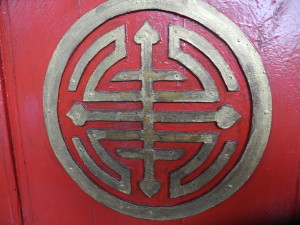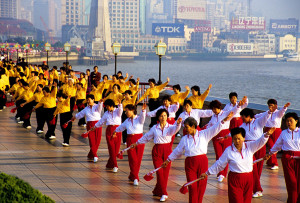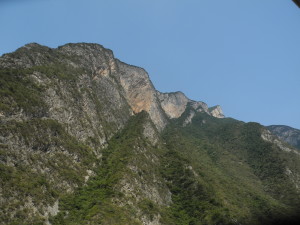Yangtze River
Sixth in a Series:

A Chinese symbol inside the Red Pagoda — if you rub it, it’s said to bring good fortune. Photo by Clark Norton.
Like all rivers, China’s Yangtze is constantly changing, though in this case humans have produced the most profound recent changes rather than nature.
The huge Three Gorges Dam project has resulted in the water level rising more than 100 to 300 feet, depending on the location and the season, along a particularly scenic stretch of the river known as the Three Gorges. The gorges, while not as dramatically steep as the pre-dam versions, are still scenic and still well worth seeing, as my wife, Catharine, and I discovered on a recent Yangtze cruise with Victoria Cruises.
The rising waters have even opened up new scenery to explore: one excursion from our ship, the Victoria Katarina, took us on a ferry ride down the… Continue reading
Fifth in a Series:
The Three Gorges Dam along China’s Yangtze is a marvel of engineering — it’s the world’s largest power station ranked by energy generation, providing hydroelectric power for millions of people — and a disaster for the 1.4 million Chinese who had to be relocated when the dam flooded the Yangtze in the late 1990’s and early 2000’s.
Some 1,500 villages, towns and cities were flooded and now lie beneath or partially beneath the river, as the water levels rose some 300 feet along the scenic Three Gorges, where steep mountains line both sides of the Yangtze.
Most former residents, many of them farmers, have been relocated to cities like Chongqing — which now has a startling population of 33 million — or to special “relocation cities,” where the river dwellers have been moved into new… Continue reading

Morning exercise teams on Shanghai’s Bund, along the Huangpu River waterfront. Photo by Dennis Cox/WorldViews
First in a Series:
Having just returned from a 12-day trip to China, in which my wife, Catharine, and I traveled independently for much of the time, I wanted to pass along some tips, cautionary information, and interesting factoids for anyone planning to visit that fascinating country in the reasonably near future — especially if you’re planning to do some independent travel.
(China is changing so fast that I can’t guarantee some things won’t be completely different a year from now.)
Our goal for the trip was to take a five-day, four-night Yangtze River cruise via Victoria Cruises, the only American-owned cruise line on the Yangtze — I’ll have an account of that in a later post. But first we wanted to stay several days in Shanghai — which I’ll be detailing later… Continue reading











